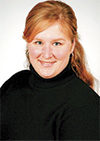He focused on five main points that are critical to a productive pasture, including mowing and dragging after each grazing event, fertilizing with nitrogen annually and for other nutrients if needed, controlling weeds with a herbicide if necessary and resting the pasture to allow regrowth.
Participants were able to see an example of a rotational grazing system and how the five components work together to increase pasture productivity.  Amanda Grev, an equine science graduate student, discussed one of her research projects focused on using small grains as emergency pasture forage.
Amanda Grev, an equine science graduate student, discussed one of her research projects focused on using small grains as emergency pasture forage.
In 2013, it was estimated that nearly 2 million acres of hay and pasture were affected by winter injury.
As a result, many horse owners were looking for emergency grazing options.
To investigate options for horse owners, winter wheat, annual ryegrass, barley, spring wheat and oat were planted in May and August 2013.
These annual grasses were selected because the seed is affordable and readily available, the grasses grow quickly, and these grasses have been successfully grazed by other livestock species.
Horses grazed the annual grasses at two different maturities and yield, forage nutritive value and horse preference were (or will be) collected.
 Many participants were impressed by the rapid growth of the annual grasses in the two weeks since planting.
Many participants were impressed by the rapid growth of the annual grasses in the two weeks since planting.
Emily Glunk, a Ph.D. candidate, showed participants a research project in progress.
The researcher team is currently investigating the effects of three different small-square bale feeders and a no-feeder control on hay waste, horse safety and economics.
Participants were able to see the different feeders and hear general observations regarding the first half of the trial.
The different designs were of interest to several of the participants and many were anxious to see the final results.  The final station focused on how to take a hay analysis.
The final station focused on how to take a hay analysis.
Dr. Krishona Martinson, equine extension specialist, had participants use a drill and hay probe to sample both small square-bales and large round-bales.
Participants learned how many samples to take per bale type, how many bales to sample per load and what side of the bale to sample from.
The discussion also focused on how to submit the analysis, what components to test for, cost of analysis and when an analysis is critical.
Many participants thought taking the sample was more difficult than it appeared. FG
PHOTOS
Photos courtesy of Krishona Martinson.

Krishona Martinson
Equine Extension Specialist
University of Minnesota












